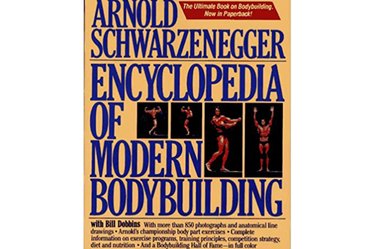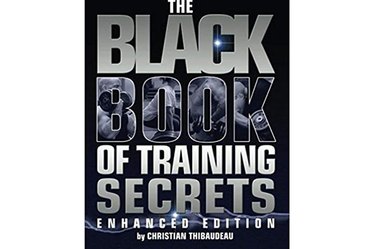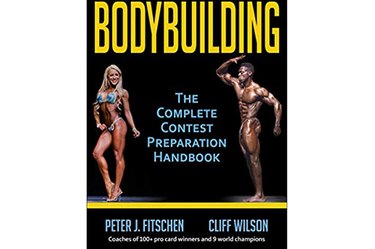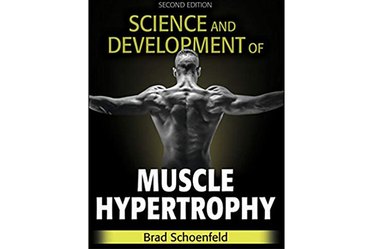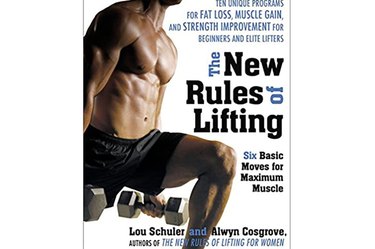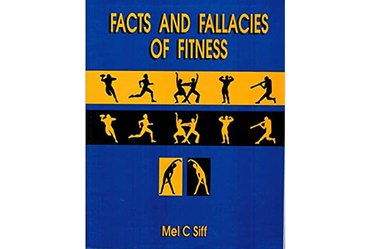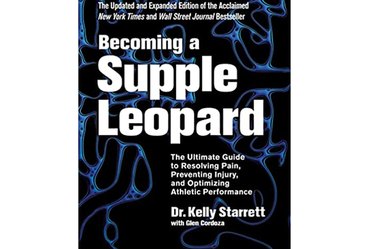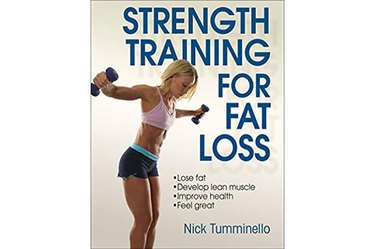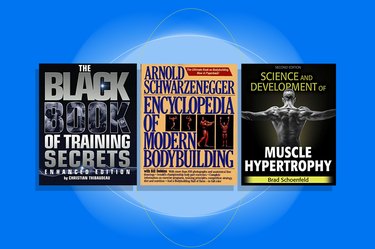
If you want to pack on muscle, you're probably going to hit the weights. But to maximize your muscle-building results, there's something else you should hit: the books.
When it comes to bodybuilding books, you've got plenty of options. Do a search for "bodybuilding" under books on Amazon, and you're slammed with more than 50,000 results. Add in a search on "muscle-building books," and the site tacks on another 7,000 choices.
Video of the Day
Video of the Day
Depending on your goals, your equipment, your time and even your attitude about training, lots of these books can be helpful. Some act like a blueprint, outlining the exact workouts to do, while others help you design your own plan. Some pack their pages with the science behind strength training, while others work from the authors' experiences coaching clients, actors, athletes and other bodybuilders.
To narrow down your choices, use this guide to help you find the best bodybuilding books to complement your goals and your training style.
How We Chose
We talked to sport scientists, strength coaches, researchers and professional bodybuilders about their favorite reads, as well as the bodybuilding books that have worked best for their clients and athletes.
A few things we considered when choosing books:
- Quality of content
- Expertise of author
- Readability
- Number of pages
1. Best Overall: 'The Encyclopedia of Modern Bodybuilding'
- Author: Arnold Schwarzenegger with Bill Dobbins
- Number of Pages: 736
The original is almost 40 years old, but this book is still the gold standard. When asked for the best bodybuilding book, just about every expert we spoke with started with Schwarzenegger's massive tome. At 736 pages, just holding this Encyclopedia may give your arms a pump.
"It's so comprehensive, and it was really the original in that [bodybuilding] area," Shawn Arent, PhD, CSCS, professor and chair of the Department of Exercise Science at the University of South Carolina, tells LIVESTRONG.com. Arent's wife, Michelle Adams-Arent, a former pro bodybuilder-turned-sports scientist at the University of South Carolina, agrees: The Encyclopedia was the only bodybuilding book she read cover to cover.
In between those covers is Schwarzenegger's personal story of rising in bodybuilding, photographs of the legendary bodybuilder performing hundreds of exercises and explanations of how and why he built his workouts, diets and pre-competition training and conditioning plans. Schwarzenegger tells you how he trained — a standard that will be tough to replicate — but also provides templates to create your own Arnold-style workouts and plans.
Buy it: Amazon.com; Price: from $38.50 (paperback)
2. Best for Designing Your Own Programs: 'The Black Book of Training Secrets'
- Author: Christian Thibaudeau
- Number of Pages: 260
While many strength-training and lifting books just show you a few specific workouts, Thibaudeau's Black Book focuses on certain principles to help you build your own.
"It shows you how to design programs, including how to choose methods and training variables and how to progress volumes and intensities to get actual results. And it is laid out well enough for anyone to follow," says Shane Davenport, CSCS, owner of Exceed Sports Performance in Westborough, Massachusetts.
"I think it's great for a number of readers," Davenport adds, "including a coach looking to expand their knowledge of program design, a weightlifter who wants to be more familiar with how to choose methods and design programs as well as any recreational athlete looking to utilize compound lifts to get bigger and stronger."
Buy it: Amazon.com; Price: $34.95 (paperback)
3. Best for Prepping for Your First Bodybuilding Competition: 'Bodybuilding: The Complete Contest Preparation Handbook'
- Author: Cliff Wilson and Peter Fitschen
- Number of Pages: 240
Most books on bodybuilding focus on just building more muscle. But if you want to transition from packing on mass in the gym to showing off muscle on stage, you'll need more targeted advice. Competing bodybuilders need to build muscle, of course, but they also need to know how to lose fat before competition without losing muscle. They need to know when to build, and when to cut. They need to know how to pose properly. And they need to know about a zillion other things that even the most massive people in the gym haven't thought of.
"The amount of information for beginner and intermediate competitors is so whole and vast. [This book] is like a road map of what to expect," says Brandon Lirio, CPT, owner of Battleground Fitness and a three-time Natural Mr. Olympia. "And it can usually guide your brain before those panic spikes most competitors get wondering if they will be ready."
The book really covers everything: It helps you choose which division is best to compete in and which competitions to enter. It has helpful photos of the mandatory poses for each division that must be performed on stage. And it guides you through getting stage-lean — and how long it's safe to stay that way.
Buy it: Amazon.com; Price: $29.95 (paperback)
4. Best for Building Your Glutes: 'Strong Curves: A Woman's Guide to Building a Better Butt and Body'
- Author: Bret Contreras
- Number of Pages: 320 pages
Many lifters want stronger glutes, but this muscle group can be tricky to target and build. Some people lose the ability to recruit those mighty muscles in their behinds when doing the exercises meant to target them — a situation referred to as gluteal amnesia or dead butt syndrome. (You can thank your stationary day job for that.)
For two decades, Bret Contreras, PhD, has been devoted to researching ways to help athletes remember — and revamp — their glutes. His longer, newer book, Glute Lab, has more comprehensive information on the anatomy and physiology of the rear end, as well as some of how Contreras became "the Glute Guy."
But if you're just looking for workouts, exercises and programs to grow your glutes, Strong Curves is for you. This no-nonsense guide provides full programs for butt-building, with helpful photos of exercises, set and repetition schemes and schedules for sculpting your ideal rear view.
Buy it: Amazon.com; Price: $24.99 (paperback)
5. Best for the Science of Building Muscle: 'Science and Development of Muscle Hypertrophy'
- Author: Brad Schoenfeld
- Number of Pages: 272
If you read an article about a "recent study" on how many sets or reps are needed to build muscle, or which rest periods are best for packing on mass, chances are the study was done by Brad Schoenfeld, PhD, CSCS. The Lehman College associate professor of exercise science seems to publish a new study on hypertrophy (building muscle mass) almost every month, adding to his resume of more than 200 publications on the topic.
Schoenfeld's background and research make this book perfect for anyone who "values evidence-based information over fitness influencers on the internet," Ashley Kavanaugh, PhD, CSCS, a sports performance coach at Renaissance Periodization, tells LIVESTRONG.com. "This is an excellent textbook for understanding the physiology and biology of skeletal muscles and connective tissue."
Science and Development of Muscle Hypertrophy acts like a giant research review, letting readers dive deep into the science of how muscle is built, comparing (and citing) studies on many different methods for building mass. The book admits there are lots of ways to build muscle, so readers can also choose which of these evidence-based findings and approaches will work for their lifestyle and training style. It also provides example programs and sidebars on practical applications to put all that science into action.
Buy it: Amazon.com; Price: from $62.10 (hardcover)
6. Best for Keeping It Simple: 'The New Rules of Lifting'
- Author: Lou Schuler and Alwyn Cosgrove
- Number of Pages: 320
Some lifting books, like 1989's Super Squats, are classics because they keep things simple. But often, they're so simple that they can be summed up in a few sentences — making the actual book more of a collector's item than a manual.
The New Rules of Lifting is simple, too, focusing on just six basic movements. But it also provides far more info for the reader. Lou Schuler, CSCS, is a longtime fitness writer and editor for publications like Men's Health, and Alwyn Cosgrove, CSCS, is the owner of Results Fitness in Santa Clarita, California. In the book, they outline the science behind focusing on these six moves, and provide a year's worth of workouts featuring them.
For beginners in the gym, this book and its spinoffs remain a valuable tool that's worthy of space on your shelf.
Buy it: Amazon.com; Price: $19 (paperback)
7. Best for Answering FAQs: 'Facts and Fallacies of Fitness'
- Author: Mel Siff
- Number of Pages: 225
Trainers and coaches often mention another book co-authored by Mel Siff, PhD, Supertraining, as a must-have. But "no one really understands that book," says Nick Tumminello, CPT, a personal trainer in Florida and author of six books on strength training. The reviews of Supertraining tend to agree — it's described as "dense," reading "like a textbook" or, as one reviewer put it, "you'll read three pages and need to sit and process it, then probably re-read those three pages again."
Facts and Fallacies has much of the same info, but it's more approachable. The book is organized into short essays, each tackling topics and themes that often puzzle lifters, like: Do you really need to warm up? Is stretching dangerous? Will squats really hurt your knees?
The book answers each of these questions (and others) with scientific information the reader can use. Some fallacies may seem outdated, and more research has been done since the book was published. But it's still valuable to the modern reader.
"This book is far more understandable and applicable, and it's just as — if not more — relevant today to help readers sort through all of the conflicting information on social media," Tumminello says.
Buy it: Amazon.com; Price: $159.99 (paperback)
8. Best for Mobility: 'Becoming a Supple Leopard'
- Author: Kelly Starrett
- Number of Pages: 480
It's not about building muscle, per se, but staying mobile and pain-free can help you stay in the gym — where you can build muscle. And when it comes to pain-free, daily mobility, Kelly Starrett, DPT, founder of The Ready State and San Francisco CrossFit, is a leading source.
Be warned: Becoming a Supple Leopard is dense, technical and comprehensive. But it's also great at taking issues step by step. The book provides lots of trial and error exercises to determine what's holding your personal mobility back — and how to address those issues. And it includes a two-week full-body mobility overhaul.
Buy it: Amazon.com; Price: $32.99 (hardcover)
9. Best for Learning Anatomy and Form Together: 'Strength Training Anatomy'
- Author: Frederic Delavier
- Number of Pages: 192
This seminal manual is like having an X-ray for exercises. In it, moves are illustrated with see-through skin, so you can see the muscle fibers underneath the arms, legs, abs, chests and backs of the illustrated exercisers, highlighting which muscles are used for which exercises and functions. And it's not just one or two of these drawings: Strength Training Anatomy has more than 600 illustrations.
"It's so detailed when it comes to really diving into the anatomy side of training," says Glenn Higgins, CPT, a certified personal trainer in Surrey, England, and owner of Glenn Higgins Fitness. He says it helped him with anatomy when he was starting out as a trainer, and he still refers back to it when building programs for celebrity clients such as singer Nicole Scherzinger.
Strength Training Anatomy doesn't provide workouts of its own, though. Instead, the X-ray images help provide the tools to understand your muscles and build workouts to target your own areas for growth. If you're looking for a more prescribed workout, Delavier also wrote several Strength Training Anatomy Workout books.
Buy it: Amazon.com; Price: $34.81 (paperback)
10. Best for Building Muscle While Burning Fat: 'Strength Training for Fat Loss'
- Author: Nick Tumminello
- Number of Pages: 280
While you can't expect to drop body fat solely with gym work (diet plays a big role), Strength Training for Fat Loss provides metabolic strength-training workouts that will get your heart pumping so you can burn fat through strength training while maintaining muscle.
Tumminello's book is a straightforward, well-illustrated guide that provides actual programs. There's some explanation of rationale and the evidence behind these exercises and workouts, but it's more of a practical workout guide than a science textbook.
Handy charts in the back mean you don't have to take a ton of notes to bring its workouts to the gym with you, either — just snap a photo of the chart with your phone, or tear it out or make a copy to track your fat-loss workout.
Buy it: Amazon.com; Price: $19.49 (paperback)
4 Things to Look for When Buying a Bodybuilding Book
When you buy a bodybuilding book, you're really buying the author's expertise. Some of the books above, like those by Schoenfeld and Contreras, are written by PhDs who publish scientific articles and are among the leading researchers in their fields. Others are written by strength coaches who have helped train and build some of the most athletic bodies in the world.
Make sure the author's expertise aligns with what you want to accomplish: If you're looking for a book on competing in a bodybuilding show, make sure the author has coached others and/or themselves to that level. If you're looking to build muscle while you're on a busy schedule, make sure the author does that as a coach. Give each author a quick search to see how they coach, what they've researched and that their credentials match your expectations.
2. Your Goals
This goes not just for the author, but especially for the content of the book. With more than 50,000 titles available, it's likely there's a bodybuilding book that will work with your schedule and your ultimate fitness desires. If you want to build strongman-level strength while packing on lean muscle, you could choose a book like Franco Columbu's Powerbuilding. Looking for bigger glutes? There are books about that. Hoping to pack on muscle in just three workouts per week? Lots of well-reviewed titles by reputable authors can fit your busy schedule.
There is no "perfect" bodybuilding book — just a perfect one for you.
3. Readability
In addition to your goals, the book should be appropriate for your current knowledge on the topic. Sometimes bodybuilding and strength-training books can be dense, filled with detailed study information, complicated anatomical terms and physiology that you might not understand without a medical dictionary nearby. And that's more than OK — it's great for the right reader.
Other books are more simply written, with joints, planes and movements written in layman's terms. In this type of book, instead of saying an exercise moves in "the frontal plane," the author might just say it moves side to side, or laterally.
Read a few sample pages of the book on the shelf or online before buying to make sure the text fits what you want in an exercise book.
4. Theory vs. Practice
Some books spend a lot of time diving deep on theory, fleshing out the science and the "why" behind different moves, set and rep schemes and workout schedules. Others just give you a plan, or a series of plans, and set you loose in the gym.
Either one can be great depending on what you want in a book. Read reviews, flip through the book in advance or check out some pages online to make sure the one you choose has the balance of theory versus practice you're after.
